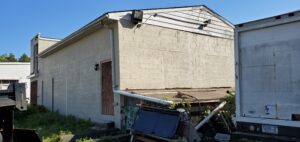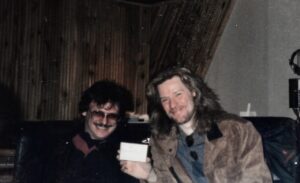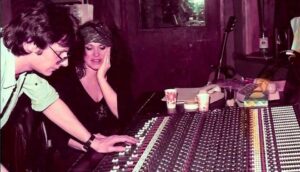
A derelict building hidden behind a car repair shop is an unlikely place to discover a remnant of rock’n’roll history.
The nondescript cinderblock structure off North State Road in Briarcliff Manor sits quietly in a storage yard amid a clutter of vehicles and metal parts.
Nearly a half-century ago, this site reverberated with the sounds of some of rock’s most revered bands, drawn to the very anonymity of the spot — and by the wizard who ran the small recording studio there.
Mike Scott first set up the studio in the early 1970s behind his dad’s car dealership as a rehearsal space for his band, Wizard. Other bands soon followed as word got around.

He soon put his performing days behind him and started Wizard Recording Studios, going into hock to purchase a top-notch console and multitrack audio equipment to record and mix master tapes for the likes of Hall & Oates, Mountain with Leslie West and Corky Laing, Melanie, Peter Frampton, Steve Marriott and Humble Pie.

Scott credits Ian Hunter’s confidence in his engineering as the breakthrough that turned up the volume on Wizard’s reputation. The former Mott the Hoople frontman rehearsed and recorded frequently with Scott, including the 1983 album, “All of the Good Ones Are Taken.”
“One of the main things about my studio was its secrecy,” Scott said recently. “We kept the lid on everything, nobody ever knew that anything was going on there until it was already gone. When Foreigner came there to work on Foreigner 4, could you imagine what it would have been like if everybody knew they were writing and rehearsing behind a Volvo dealership in Briarcliff Manor?”
Bands flocked to Wizard for the laid-back attitude and its knack for nailing their authentic sound.
“What we had was one big studio,” Scott recalled. “We had three rooms in a semicircle around the control room, because our approach was to capture as much of the band’s tracks live as we could but still get as much separation as we could between the instruments. So we’d put the drums in one room, we’d put the grand piano in another room — we had a Steinway grand, we put that in a separate room — and then we’d put the guitars and the main vocalists in the front room.”
Scott had Wizard’s drum room designed with one wall built of granite, marble and brick to control the echo.

Sometimes a recording session took an unorthodox turn, like the night he went out on the roof to record the vocals for Melanie’s cover of the Four Seasons’ hit, “Rag Doll.”
“I set up a vocal mic and a set of headphones for each of us and I sat in a chair and she sang the song out there,” Scott said. “She wanted atmosphere, so I created some atmosphere.”
During the recording session, Melanie’s husband and producer, Peter Schekeryk, came bursting out of the bathroom yelling: “I know what we need, sleigh bells!” And indeed, sleigh bells were mixed into her version of “Rag Doll.”
Other rock luminaries who either recorded or rehearsed at Wizard included Al Kooper, the Isley Brothers and Ronin — composed of members of Linda Ronstadt’s backing band. The studio also recorded tracks by jazz fusion guitar virtuosos Al DiMeola and John McLoughlin.
Scott shuttered the studio in the late 1980s after the property was sold.
It didn’t take long for his next career move: Heading out on the road in Europe as a sound man for Deep Purple, Mountain and Meatloaf. That was the beginning of a long string of gigs that included audio engineering for Mariah Carey and Grammy-nominated work with Kenneth Brian Edmonds, aka Babyface.
Scott also worked on Hall and Oates’ platinum-selling album, “Ooh Yeah,” at Hall’s home in Pawling, NY.
‘Middle of nowhere’
Bob Hansmann gave guitar lessons in an upstairs room at Wizard, away from the recording sessions happening downstairs. But occasionally a guitarist dropped in for an impromptu jam session — including Frampton.
“Oh, man, we played all night, it was a lot of fun,” Hansmann said of the night he swapped licks with the British rock star. “I don’t even remember what we played, one thing into another. We were just trading ideas all night long.”
Hansmann still marvels at Scott’s success in attracting top acts to “the middle of nowhere.”
“He was able to run with the big dogs,” Hansmann said. “He was able to establish himself as someone worthy of respect in circles that are very, very powerful in the music business, like CBS and Atlantic. You just didn’t expect that in that area, and Mike said, ‘Why not,’ and he did it.”
Warren Hammer was an assistant engineer and studio manager at Wizard who worked on Al De Miola’s “Tour De Force” album and other projects at the studio.
“If the engineering was good and the console was good, people would find their way there,” he said, noting the studio’s out-of-the-way location.
Hammer, who lives in Ossining, subsequently worked as a technician on live events and as technical director at Caramoor Center for Music and the Arts. He noted that several Wizard alumni later became renowned in the field, including legendary studio designer Francis Manzella and Grammy Award-winning audio engineer Phil Magnotti.
Still in the mix
Although he worked with some of the most talented artists in the genre, Scott was never star struck.
“You gotta understand something about me,” he said. “I was about the music and the work, not about the glitz. I was about being an engineer.”
Scott is still about being an engineer, recording and mixing music in his studio in Putnam Valley.
The rock music business isn’t the same, and that’s not just because of the switch from analog to digital technology.
“The spirit of the music was to write music for a cause and to be able to stand on a box and yell your opinion out there,” Scott said. “Now the culture has gotten to be very regulated and confined … and everything that you hear is almost the same thing all the time.”
“We had so many great writers in the old days, we don’t have that anymore,” he said. There are very few really good songwriters. Where are the Bob Dylans and the Elton Johns and the John Lennons and the George Harrisons, and Carole King?”
Scott added: “I still believe one-hundred percent in the purpose of what we started way back before Woodstock, and at Woodstock, and carried on. I believe that what we said then was right.”
More on Briarcliff’s Claim to Rock’N’Roll Fame
Rock to Rubble: Howard Stern’s One-Time Studio Faces Wrecker’s Ball
Meg Griffin Remembers WRNW FM, Rock’s ‘Glorious Playhouse’ in Briarcliff Manor







I A/E’d there in the early 80s along with Phil Magnotti…Peter Frampton, Bob Mayo and John Regan were REALLY nice guys to work around as was Ian Hunter. I remember being terrified of having an accident after picking up the MASTERS for Foreigner 4 from Electric Lady in NYC in Mike’ fathers Volvo station wagon and bringing them back to the studio. LOL!
Hi Chris. I’m surprised I never knew about this place. Especially considering it was behind my Saab dealer!
Hope you’re well
W Wittman
I can answer that having lived there for a couple of years in the early 90’s. We had a Harrison MR-2 console with Valley People automation. A Studer A-80 Mk3 24 track multi and a Studio A-80 1/2″ mixdown deck.
Hammond B-3 with 145 Leslie, Marshall 50watt stack, several other guitar amps, and lots of nice microphones…. classics.
My job was to rebuild all of that equipment and keep it working, and be the live-in assistant engineer. Good times!
I did. The Latest recorded there in 81 and 82. Dave produced.
Did you work with Dave marsac at Wizard?
Mike Scott – can you detail the setup you had? Primary console(s), matched mics? Any house gear besides the Steinway that became “must have” on recordings? Any Grammy awards/nominations for your work?
Pretty easy to find with the info in the article actually. ????
WHERE is this? The Internet is international, your local paper is seen by everyone.